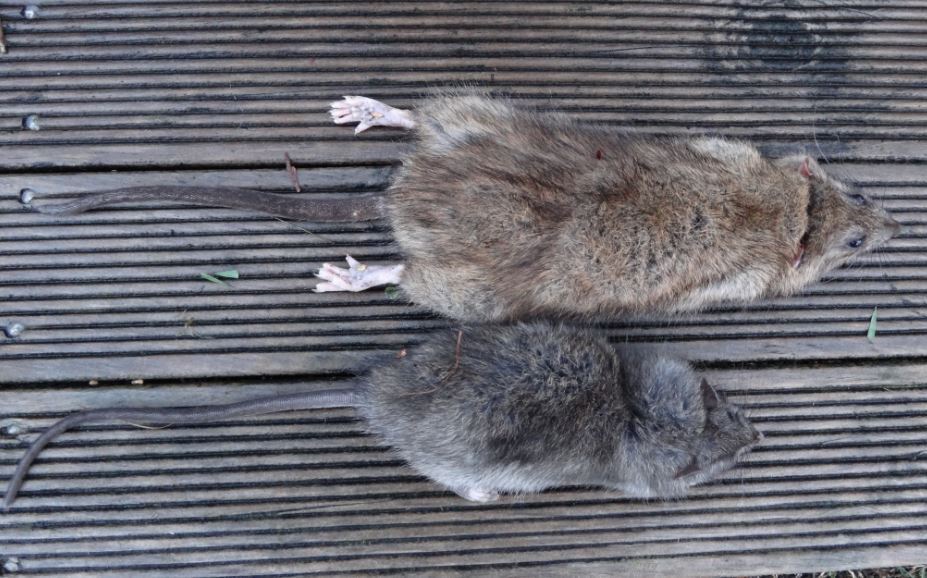Black Rat
Rattus rattusSummary 7
The Black rat (Rattus rattus), is also known as the Blue rat, Bush rat, House rat, Roof rat, Ship rat, and Matapo. In New Zealand it is most common in bush and forested areas as it was pushed out of urban areas by the larger Rattus norvegicus.
Identification 8
Weight
Typically 120g - 160g (up to 225g)
Length, head-plus-body
225mm (max)
Tail
Much longer than head-plus-body length;
Uniformly dark all over.
Ears
19.0mm - 26.0mm;
Hind-foot, length
28.0mm - 38.0mm (adult)
Hind-foot, colour of upper-side
Uniform colouring over whole foot, usually dark.
 🔗
🔗Fur, colour on back
Three colour variations:
- rattus: uniformly black;
- alexandrinus: brown with long black guard hairs;
- frugivorous: brown with long black guard hairs.
Fur, colour on belly
Three colour variations:
- rattus: uniformly grey;
- alexandrinus: uniformly grey;
- frugivorous: uniformly white or creamy-white.
Habits
- Very agile and frequent climber;
- Rarely burrows;
- Nests mainly in trees and shrubs;
- Infrequent swimmer.
Identification features based on https://www.stat.auckland.ac.nz/~smiller/rat_id
Comparisions 8
Comparison of R. rattus (top) and R. norvegicus (bottom):
Comparison of R. norvegicus top, R. rattus bottom:
Comparison of R. rattus and R. norvegicus ear hairs - sometimes R. rattus ears are described as naked and R. norvegicus ears are described as 'hairy', but it depends on how closely you look at them. Both have hairs, but diagnostically you can differentiate them by zooming right in:
R. rattus - fine hairs do not extend beyond edge of ear :
 🔗
🔗
R. norvegicus -obvious hairs extend beyond edge of ear:
Most iNaturalist photos aren't really high enough resolution to detect this difference though.
Juvenile rats 8
All the above applies to adult rats, we really need a section dealing with the differences seen in juvenile rats. This is just a placeholder for that section!
Notes about identifying dead rats 8
Identification features such as head shape, ears, and eyes can be affected by being squashed in a trap, eg "large" eyes may simply be the result of the eyes bulging out as a result of head trauma.
Wet fur usually looks dark, so a wet Brown rat may well look black.
And remember "it is not necessarily a straight-forward task identifying what you have caught. The information provided can be fairly variable/vague and should be taken with a grain of salt. Every source says that an identification should be made based on the weight of identifying features, as it is rare to find a specimen matching every feature perfectly. " (🔗rat_id)
Sources and Credits
- (c) Ryanwebb, some rights reserved (CC BY-NC), uploaded by Ryanwebb, https://inaturalist.nz/observations/156814033
- (c) Christopherstephens, some rights reserved (CC BY-SA), uploaded by Christopherstephens, https://inaturalist.nz/observations/164153478
- (c) Nlitjens, all rights reserved, uploaded by Nlitjens, https://inaturalist.nz/observations/145819168
- (c) Lifelearnerstaranaki, some rights reserved (CC BY-NC), uploaded by Lifelearnerstaranaki, https://inaturalist.nz/observations/16196873
- (c) Oneangrycyclist, some rights reserved (CC BY-NC), uploaded by Oneangrycyclist, https://inaturalist.nz/observations/167589967
- (c) strewick, some rights reserved (CC BY), uploaded by strewick, https://inaturalist.nz/photos/313911552
- Adapted by Tony Wills from a work by (c) Wikipedia, some rights reserved (CC BY-SA), https://en.wikipedia.org/wiki/Rattus_rattus
- (c) Tony Wills, some rights reserved (CC BY-SA)
More Info
- iNaturalist NZ taxon page
- Animal Diversity Web
- ASM Mammal Diversity Database
- Atlas of Living Australia
- Biodiversity Heritage Library
- BOLD Systems BIN search
- CalPhotos
- Global Biodiversity Information Facility (GBIF)
- iNaturalist Mammal Working Group
- Maryland Biodiversity Project
- NatureServe Explorer 2.0
- NBN Atlas
- Rat identification in New Zealand
- VertNet
- 日本のレッドデータ検索システム


















